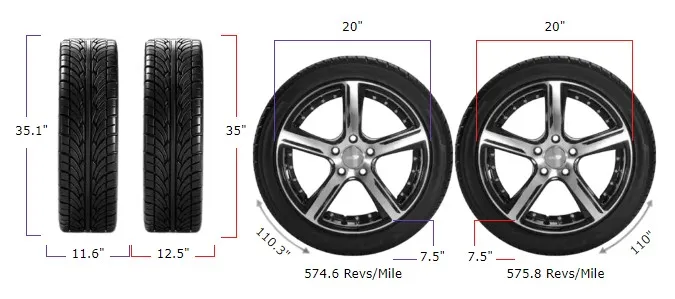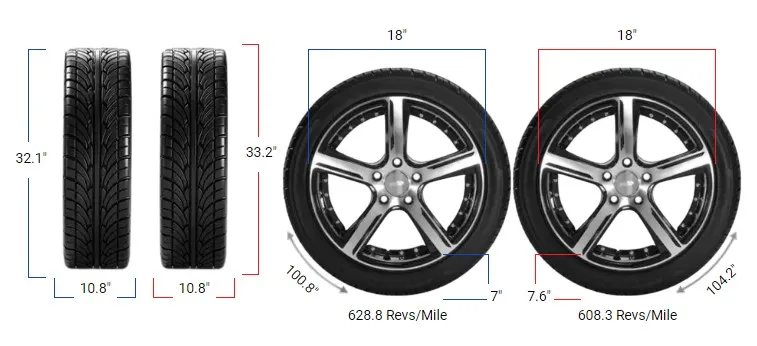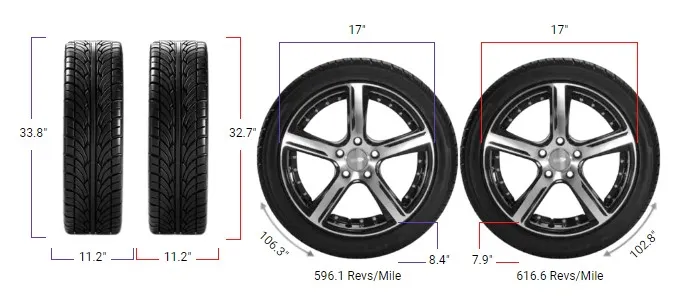Tire Size 295/65r20 vs 35×12.50r20

While this upgrade can offer some benefits, it’s important to understand the key differences between these tire sizes and how they may impact your vehicle’s performance both on and off the road. Let’s take a closer look at what you need to know before making the switch.
- Wider tires provide a larger contact patch for improved traction off-road
- Minimal impact on ride comfort, fuel economy, and speedometer accuracy on pavement
- Slightly improved handling and stability on-road due to increased tire width
- Negligible difference in ground clearance with only a 0.2% change in diameter
- Potential for increased tire wear and reduced tread life with wider tires
- No major fitment concerns as diameter difference falls within acceptable range
- Overall, most noticeable differences will be in off-road performance rather than on-road driving
295/65r20 vs 35×12.50r20 Table
The primary difference between 295/65r20 and 35×12.50r20 tires is the width.

Fitment Guide
The overall diameter difference should not exceed 3% to avoid rubbing or clearance issues. In this case, 35×12.50r20 tires are only 0.2% smaller in diameter than 295/65r20 tires, with a difference of just -0.07 inches (-1.9mm).
This falls well within the acceptable range, so fitment should not be a major concern when switching between these sizes.
On-Road Impact
Switching to a wider tire can affect various aspects of on-road performance. Here are some key areas to consider:
- Ride Comfort: The wider footprint of 35×12.50r20 tires may result in a slightly stiffer ride, especially on smooth pavement. However, the difference in sidewall height is minimal at just -0.04 inches (-0.95mm) or -0.5%, so the impact on overall ride comfort should be negligible for most drivers.
- Fuel Economy: The larger contact patch of wider tires can lead to increased rolling resistance, which may slightly reduce fuel efficiency. However, with only a -0.2% difference in overall diameter and circumference, the effect on gas mileage is likely to be minor when switching from 295/65r20 to 35×12.50r20 tires.
- Speedometer Accuracy: Tire size can affect speedometer readings, but in this case, the difference is minimal. At 20 mph (32.19 km/h), the actual speed with 35×12.50r20 tires would be 19.96 mph (32.12 km/h) – a negligible difference of just 0.04 mph (0.07 km/h).
- Handling: Wider tires generally provide improved lateral grip and stability, especially during cornering or in wet conditions. The increased width of 35×12.50r20 tires may offer a slight handling advantage over 295/65r20 tires, but the difference may not be noticeable to most drivers in normal driving situations.

Off-Road Impact
If you plan to take your vehicle off-road, tire size can make a bigger difference. Here’s what you should know about the off-road performance of 35×12.50r20 tires compared to 295/65r20 tires:
- Traction: The larger contact patch of 35×12.50r20 tires can provide better traction on loose or uneven surfaces like sand, mud, or rocks. The extra width allows the tires to flatten out more, increasing the surface area in contact with the ground for improved grip.
- Ground Clearance: While the overall diameter difference is small at just -0.07 inches (-1.9mm) or -0.2%, every bit of extra ground clearance can be beneficial when navigating rough terrain. However, the slight decrease in diameter with 35×12.50r20 tires is unlikely to have a significant impact on most off-road situations.
- Durability: Wider tires with a larger contact patch may be more prone to punctures or sidewall damage from sharp rocks or other hazards when off-roading. However, this depends more on the specific tire construction and tread design than the size difference alone.
What is the Difference Between 295/65r20 and 35×12.50r20?
The main difference between 295/65r20 and 35×12.50r20 tires is the width. A 35×12.50r20 tire is 0.91 inches (23 mm) wider than a 295/65r20 tire.
The diameter, circumference, and sidewall height are slightly smaller on the 35×12.50r20 tire, but the differences are minimal (less than 1%).
Can I Use 35×12.50r20 Instead of 295/65r20?
Yes, you can use 35×12.50r20 tires instead of 295/65r20 tires. The overall diameter difference between the two sizes is only -0.07 inches (-1.9 mm) or -0.2%, which falls within the generally accepted 3% difference range.
This means that using 35×12.50r20 tires should not cause any significant issues with vehicle handling, speedometer accuracy, or overall performance.
How Much Taller Is a 295/65r20 Tire Than a 35×12.50r20?
A 295/65r20 tire is approximately 0.07 inches (1.9 mm) taller than a 35×12.50r20 tire. The overall diameter of a 295/65r20 tire is 35.1 inches (891.5 mm), while a 35×12.50r20 tire has a diameter of 35.02 inches (889.6 mm). The difference in height between the two sizes is minimal at around 0.2%.
How Much Wider is a 35×12.50r20 Tire Than a 295/65r20?
A 35×12.50r20 tire is 0.91 inches (23 mm) wider than a 295/65r20 tire. The width of a 295/65r20 tire is 11.61 inches (295 mm), whereas a 35×12.50r20 tire has a width of 12.52 inches (318 mm).
This represents a 7.8% increase in width when switching from a 295/65r20 to a 35×12.50r20 tire size.
Our Observations
After analyzing the key differences between 295/65r20 and 35×12.50r20 tires, we believe that switching to the wider size can offer some advantages, particularly for off-road use.
The nearly 1-inch increase in width provides a larger contact patch for improved traction on loose or uneven surfaces.
On the road, the wider tires may slightly improve handling and stability, but the difference in ride comfort, fuel economy, and speedometer accuracy is likely to be minimal.
Overall, the impact of switching from 295/65r20 to 35×12.50r20 tires will be most noticeable in off-road situations, while the differences on pavement may be negligible for most drivers.
As always, it’s important to consider your specific vehicle, driving habits, and intended use when selecting the best tire size for your needs.



